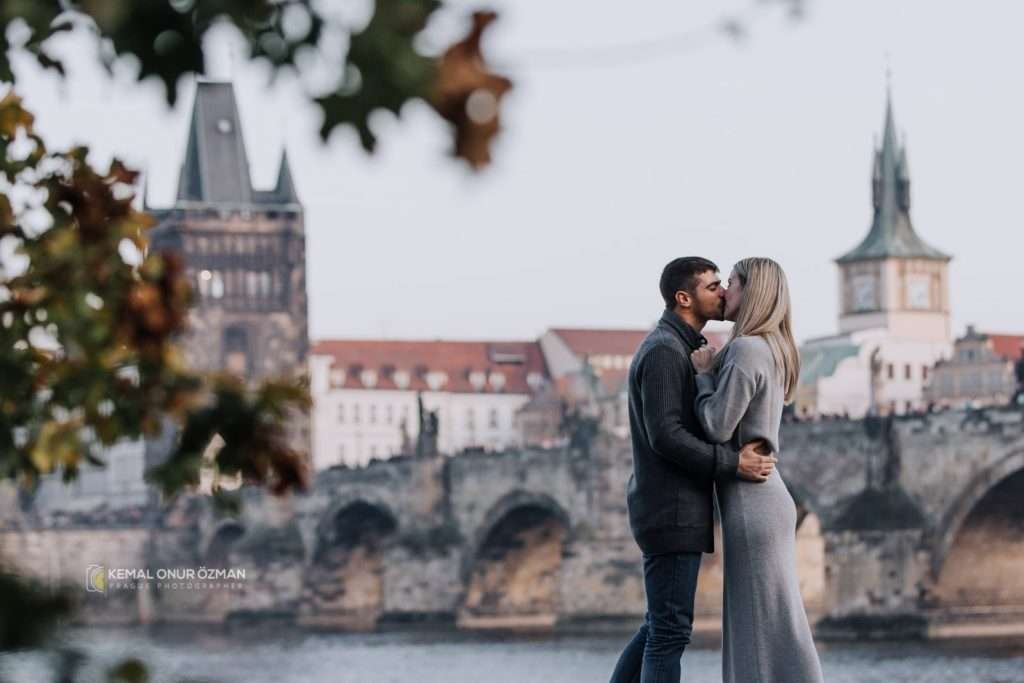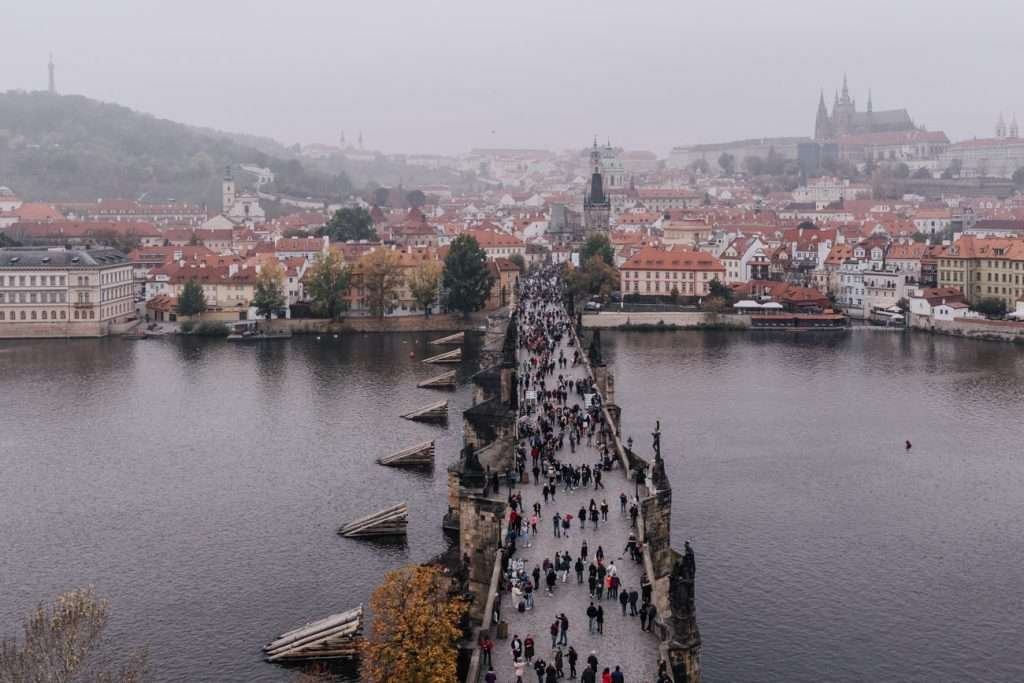查尔斯桥的永恒故事布拉格的标志性杰作
雄伟地耸立在伏尔塔瓦河上、 查理大桥 布拉格大桥不仅仅是一座桥,它还是布拉格跳动的心脏,是交织着历史、艺术和传奇的中世纪奇迹。近 700 年来,这座石头巨桥一直是捷克共和国坚韧不拔精神的象征,它将历史悠久的老城与庄严的马拉斯特拉娜(Malá Strana)和布拉格城堡连接起来。查理大桥上装饰着 30 座巴洛克式雕像,两侧是哥特式塔楼,充满了国王、圣人和战争的故事,是布拉格灵魂的活画廊。让我们踏上一段丰富的历史之旅,揭开有趣的事实,探索雕像背后的故事,并回答使这座地标成为无数人必游之地的问题。

一座诞生于皇室的桥查理大桥的历史
1357 年,在具有远见卓识的 查理四世国王在这座欧洲最具标志性的桥梁建成之后,它就开始了施工。由建筑师 彼得-帕莱日该桥取代了 朱迪丝-布里奇这座 12 世纪的石头建筑毁于 1342 年的一场特大洪水。查尔斯四世是神圣罗马帝国的皇帝,对数字命理学情有独钟,他选择了一个吉祥的时刻来奠定第一块石头: 1357 年 7 月 9 日凌晨 5:31形成了 135797531 的谐音,人们相信这座桥具有神秘的力量。

这座桥于 1402 年竣工,最初被称为 石桥 或者 布拉格大桥-它横跨伏尔塔瓦河,全长 516 米,有 16 个拱门,是中世纪工程技术的见证。直到 1841 年,它一直是唯一的过河通道,使布拉格成为东欧和西欧之间重要的贸易枢纽。1870 年,它被正式命名为 查理大桥 以纪念其创始人。
几个世纪以来,这座桥历经洪水、战争和革命,经历了多次维修和修复。如今,它已成为行人专用的地标性建筑,自 1992 年起被联合国教科文组织列为世界文化遗产,吸引着无数游客前来欣赏其迷人的景色和充满传奇色彩的过去。

让人难忘的查理大桥趣事
鸡蛋传奇:一个离奇的传说称,这座桥的砂浆中掺入了数千个蛋黄,以增强其强度。据报道,一个名叫维尔瓦里(Velvary)的村庄因担心生鸡蛋会在途中破裂,误送了煮熟的鸡蛋。虽然科学家们对鸡蛋理论争论不休,但这个故事为这座桥的传说增添了异想天开的魅力。
数字魔法:国王查理四世对数字的痴迷使得大桥的奠基仪式选在了万年历的时刻,据说这可以利用宇宙的力量。奇数(1357)被排列成金字塔形,以增加象征意义。
好莱坞明星:查尔斯-布里奇曾在以下电影中客串角色 蜘蛛侠:归来, 不可能的任务不可能的任务, 和 XXX其永恒之美吸引着全世界的观众。
大胡子:雕刻在护栏上的石雕头像,被称为 布拉达奇 (大胡子)是中世纪的洪水警报器。如果水漫到他的胡子上,就该逃到高处去了。
收费故事:在 1816 年之前,过桥需要支付通行费,资金用于维护。想象一下,当旅行者穿过大桥前往布拉格城堡时,硬币叮当作响的情景吧
雕像的故事:大桥的守护者
查理大桥是一座露天画廊,装饰着 30 座巴洛克雕像 主要建于 1683 年至 1714 年之间。这些雕塑大多描绘的是圣人和守护神,由以下大师精心制作 马蒂亚斯-布劳恩 和 扬-布罗可夫.虽然雕像的原件现在保存在国家博物馆的 Lapidarium 等博物馆中,但它们的复制品仍然令游客着迷。以下是一些杰出的雕像及其故事:
圣约翰·内波穆克:最有名的雕像建于 1683 年,是为了纪念 1393 年因拒绝向国王温塞拉斯四世透露王后的忏悔而被投入伏尔塔瓦河的捷克殉道者。传说他死后,河面上出现了五颗星星,现在他的光环中就有这五颗星星。据说触摸雕像下方的铜牌可以带来好运,并确保返回布拉格。
圣路易加迪斯:这座雕像由马蒂亚斯-布劳恩(Matthias Braun)于 1710 年制作,描绘了一位失明修女看到耶稣俯身让她亲吻自己伤口的情景。这座雕像被认为是这座桥的艺术杰作,它捕捉到了原始的情感和巴洛克式的戏剧性。
圣十字架和各各他:最古老的纪念碑可追溯到 14 世纪的十字架,现在的青铜十字架安装于 1657 年。1696 年,为了惩罚一名被控亵渎神明的犹太领袖,十字架上又增加了希伯来文铭文 "神圣、神圣、神圣"。
布伦奇维克: This knight, not part of the main 30 statues, stands on a pedestal in the water. According to legend, Bruncvík wielded a magical sword buried in the bridge, to be unearthed in the Czech nation’s hour of need. The original was damaged in the Thirty Years’ War, and a replica by Ludvík Šimek now stands.
Saints Vincent Ferrer and Procopius: Created by Ferdinand Brokoff in 1712, this statue shows the saints holding a model of the bridge, symbolizing protection against floods. A mythical knight Bruncvík stands behind, adding a layer of folklore.
Each statue reflects Prague’s religious and cultural heritage, commissioned by craft guilds to honor their patrons—like St. James for cutters or St. Joseph for carpenters. Their baroque and gothic styles blend seamlessly, making the bridge a visual feast.
Historical Background: A Witness to Time
Charles Bridge has been a silent witness to Prague’s triumphs and tragedies. Built during the height of the Holy Roman Empire, it solidified Prague’s status as a cultural and political center. Its strategic importance made it a focal point during conflicts, from medieval revolts to modern wars.
Battle of White Mountain (1620): After the defeat of Protestant rebels, the heads of 27 executed leaders were displayed on the Old Town Bridge Tower in 1621 as a warning against resistance.
Thirty Years’ War (1618–1648): In 1648, Swedish forces occupied the west bank of the Vltava and fought fiercely on the bridge to capture the Old Town. The battle damaged the Old Town Bridge Tower, stripping it of its gothic decorations.
Revolutionary Days (1848): The bridge survived cannon fire during the 1848 uprisings, though some statues were damaged.
World War II: Remarkably, Charles Bridge emerged nearly unscathed from the war, despite Prague’s occupation. A barricade was built at the Old Town Bridge Tower in 1945 to resist German forces.
Beyond wars, the bridge faced nature’s wrath. Major floods in 1432, 1496, 1890, and 2002 tested its resilience, with the 1890 flood causing three arches to collapse and statues to fall into the river. Each time, repairs restored its glory, with significant reconstructions in 1965–1978 and 2008–2010 reinforcing pillars and adding a hydroisolation system. A 20-year restoration began in 2019 to preserve its ice guards and sandstone blocks, costing an estimated 45–60 million CZK.
Destruction and Reconstruction: A Bridge Reborn
Charles Bridge has never been completely destroyed, but it has faced significant damage requiring extensive repairs:
1432 Flood: Three pillars were destroyed just 30 years after completion, repaired by 1442.
1496 Flood: The third arch collapsed after a pillar was undermined, with repairs completed in 1503.
1890 Flood: One of the most severe floods washed away three arches and toppled statues. Repairs took two years and cost 665,000 crowns, reopening the bridge in 1892.
2002 Flood: While causing minimal damage, this flood spurred support for modern reinforcements, leading to the 2008–2010 reconstruction.
The bridge’s ability to withstand these disasters is a testament to its robust design, with 16 arches and ice guards protecting its sandstone structure. The 1965–1978 repair removed asphalt decking and replaced broken stones, while the ongoing 2019–2039 restoration ensures its longevity for future generations.
The Statues: Number and Meanings
The bridge hosts 30 statues and statuary groups, plus the additional 布伦奇维克 statue on a pillar. These baroque masterpieces, erected between 1683 and 1938, primarily depict saints venerated in Bohemia, each with unique symbolism:
St. Ivo: Patron of lawyers, depicted with Justice, symbolizing fairness.
St. Barbara, Margaret, and Elisabeth: Representing martyrdom and charity, these saints were sculpted by Jan and Ferdinand Brokoff.
St. Christopher: Patron of travelers, shown carrying Jesus across a river, symbolizing protection.
St. Wenceslas: Patron of the Czech lands, a symbol of national pride.
St. John of Matha, Felix of Valois, and Ivan: Depicting the Trinitarian Order’s mission to free Christian prisoners, with a dungeon scene at the base.
The statues, mostly sandstone, have darkened over time due to pollution, but recent renovations reveal their original golden hue. Many originals are preserved in the Lapidarium or Vyšehrad’s Gorlice Hall, with replicas ensuring the bridge remains a vibrant gallery.
Wars Witnessed by the Bridge
Charles Bridge has seen several major conflicts over its 650-year history:
Hussite Wars (1419–1434): The bridge was a key crossing during religious conflicts, with a crucifix destroyed by Hussites in the early 15th century.
Thirty Years’ War (1618–1648): The 1648 Battle of Prague saw intense fighting on the bridge, damaging the Old Town Bridge Tower.
Revolutions of 1848: The bridge endured cannon fire during Prague’s revolutionary uprisings.
World War II (1939–1945): The bridge survived with minimal damage, serving as a defensive point in 1945.
These conflicts shaped the bridge’s legacy as a symbol of endurance, standing firm through centuries of turmoil.
5 FAQs About Charles Bridge
- Is Charles Bridge open to the public, and is there a fee?
Yes, the bridge is open 24/Sybil Manton / Shutterstock
The bridge is open to pedestrians 24/7, and there’s no entrance fee, making it accessible to all visitors. - How long and wide is Charles Bridge?
The bridge is approximately 516 meters (1,693 feet) long and 9.5 meters (33 feet) wide, supported by 16 arches. - What is the story behind the statue of St. John of Nepomuk?
St. John of Nepomuk was a priest martyred in 1393 for refusing to divulge the queen’s confessions. Thrown into the Vltava from the bridge, his statue is said to bring luck when touched. - Why was Charles Bridge built?
It was commissioned by King Charles IV to replace the flood-destroyed Judith Bridge, connecting Prague Castle with the Old Town and boosting trade. - How many statues are on the bridge, and are they original?
There are 30 statues, mostly baroque, depicting saints. Most are replicas, with originals preserved in museums to protect them from damage.
Why Charles Bridge Captivates the World
Charles Bridge isn’t just a crossing over the Vltava—it’s a journey through time. Its gothic towers, baroque statues, and legends of knights and saints create an atmosphere that’s both enchanting and humbling. Whether you’re rubbing St. John’s plaque for luck, marveling at the views of Prague Castle, or tracing the scars of wars and floods, the bridge invites you to become part of its story. Visit at dawn for a serene stroll or at night when its illuminated silhouette feels like a fairytale. Charles Bridge is Prague’s jewel, a masterpiece that continues to inspire awe and wonder.
Plan your visit today, and let the bridge’s magic unfold before you. Touch the cross, make a wish, and let Charles Bridge etch itself into your heart—just as it has for centuries.
布拉格查理大桥与人合影

















查理大桥是一座历史悠久的桥梁,横跨捷克共和国布拉格的伏尔塔瓦河。它由国王查理四世委托建造,建于 1357 年至 1391 年之间。这座桥由建筑师彼得·帕勒 (Peter Parler) 设计,被认为是哥特式建筑的杰作。它装饰着 30 座圣徒雕像,这些雕像是在 17 和 18 世纪添加的。查理大桥是一个受欢迎的旅游景点,也是布拉格深受喜爱的象征。它也是一条重要的交通路线,将城市的老城区和小城区与城堡区和城堡区连接起来。
查理大桥上装饰着 30 座巴洛克风格的圣人雕像,这些雕像是在 17 和 18 世纪添加到桥上的。这些雕像由各种艺术家创作,代表了捷克、波西米亚和欧洲圣徒的混合体。
以下是雕像及其对应圣徒的列表:
Nepomuk 的圣约翰(波西米亚的守护神)
帕多瓦的圣安东尼
洛约拉的圣依纳爵
马塔的圣约翰(至圣三一会的创始人)
圣弗朗西斯泽维尔
圣文森德保罗
圣菲利普内里
克桑滕的圣诺伯特
河马的圣奥古斯丁
施洗者圣约翰
亚历山大的圣凯瑟琳
匈牙利的圣伊丽莎白
St. Wenceslaus(捷克共和国的守护神)
St. Adalbert of Prague(布拉格的守护神)
圣维特(捷克共和国的守护神)
圣乔治
St. Vojtěch(捷克共和国的守护神)
圣卢德米拉(捷克共和国的守护神)
St. Prokop(捷克共和国的守护神)
圣亨利
圣科斯马斯和圣达米安
圣塞巴斯蒂安
圣洛克
圣罗莎莉亚
十字架的圣约翰
抹大拉的圣玛利亚
阿西西的圣弗朗西斯
阿西西的圣克莱尔
圣十字
圣卢加达
除了雕像,查理大桥还装饰有许多其他装饰物,包括路灯、十字架和盾形纹章。这座桥是游客的热门目的地,他们前来观看雕像并欣赏城市的美丽景色。
[…] Charles Bridge […]